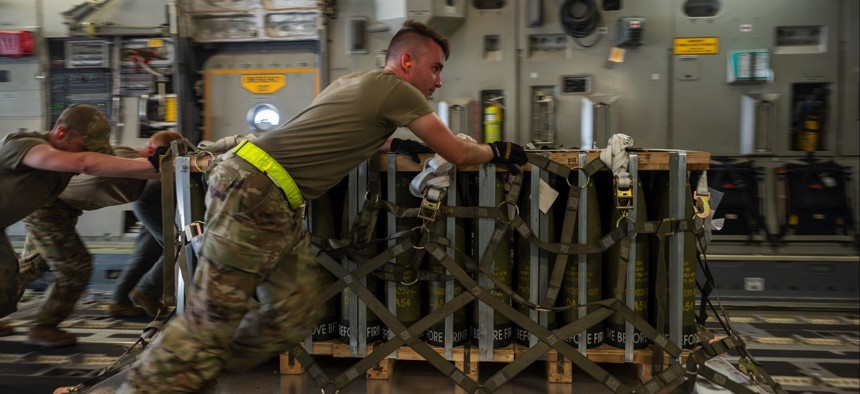
Airmen load pallets of ammunition onto a C-17 Globemaster III bound for Ukraine during a security assistance mission. Airman 1st Class Cydney Lee, U.S. Air Force
Arms Flow 30% Faster to Ukraine as US Relearns Cold-War Skills
Logisticians are honing techniques invented to keep the Soviet Union from seizing Europe.
Eager Ukrainian soldiers are getting their guns and ammo faster than ever, thanks to the work of the U.S. government’s top bulk shipper: the U.S. military.
The Europe-based unit in charge of shipping weapons to Ukraine has sped up deliveries by 30 percent compared to the start of Russia’s full-scale invasion last year, said a spokesperson for the U.S. Army’s 21st Theater Sustainment Command.
“We have definitely learned how to be more efficient with our transportation,” the spokesperson said.
The spokesperson attributed the improvements to increasing experience, after-action reports, and an improved ability to forecast operations.
The acceleration comes as the U.S. Army relearns Cold War-era techniques for quickly moving soldiers and materiel across the 3,000 nautical miles that separate the U.S. from its European allies.
The U.S. first began dusting off the skills necessary to speed troops and weapons across the Atlantic in 2019, when it launched the annual DEFENDER-Europe exercise. The exercise sees thousands of troops deploy from the U.S. to Europe, an echo of the REFORGER wargames that prepped NATO forces to defeat a Soviet invasion of Western Germany.
The U.S. effort to help Ukraine started out relatively small. In December 2021, the U.S. authorized $200 million in lethal aid to Ukraine amid fears Russia would invade.
A lightly staffed unit called the Doctrine Education Advisory Group, or DEAG, was tapped to help inventory the equipment when it reached Ukraine. The group more typically worked on helping Ukraine revamp its military education courses, but threw itself into the task.
“My guys were pulling equipment until we actually had to leave,” U.S. Army Col. Andrew Clark, commander of the unit that oversees DEAG, told Defense One.
Since then, the flow of weapons to Ukraine has increased exponentially. As of May 21, the U.S. has shipped or promised to ship $38 billion worth of equipment and weapons to Ukraine, much of it from U.S. stockpiles.
Among the many bulky packages delivered or coming to Ukraine are two million 155mm artillery shells, each weighing 95 pounds; and 2,000 Humvee trucks, weighing around three-and-a-half tons. A total of 749 infantry fighting vehicles and armored personnel carriers have also been promised, with 31 Abrams tanks arriving in Ukraine in the fall.
This flow of arms has helped replenish Ukraine’s munitions stockpiles and bestowed new abilities to strike deep into Russian-occupied territory.
The U.S. military also increased its presence in Europe by 20,000, bringing the total of U.S. service members on the continent to 100,000.
The Army has occasionally run into speed bumps as it ramps up to once again face a Russia eager to reclaim at least some of the boundaries of the old Soviet Union.
Amid the rumbles of a possible Russian invasion, Army logisticians’ raced round the clock in early 2022 to outfit an entire Army brigade combat team arriving from the United States. They achieved their goal twice as fast as expected, earning plaudits from the Army chief of staff.
A Defense Department Inspector General investigation likewise noted the speed, but found that around 10 percent of equipment issued from pre-positioned stockpiles was not up to snuff.
Among the problems was an inability to run vehicles on exercise tracks, as called for in their maintenance instructions, as these exercise tracks had never been built.
“When the Cold War ended, the idea that you would have to rapidly pull equipment out of storage in Europe just didn’t seem very likely,” Mark F. Cancian, a senior advisor at the Center for Strategic and International Studies, said in March.




